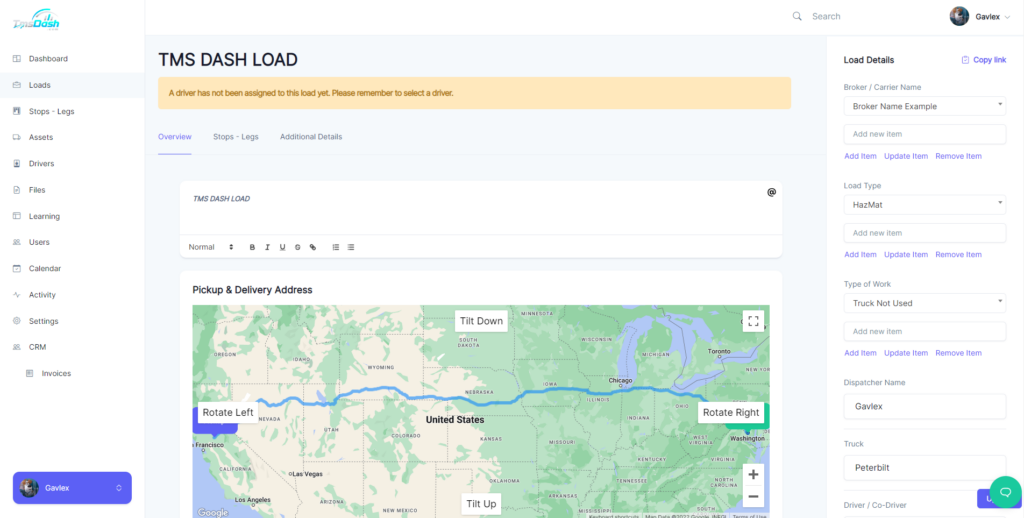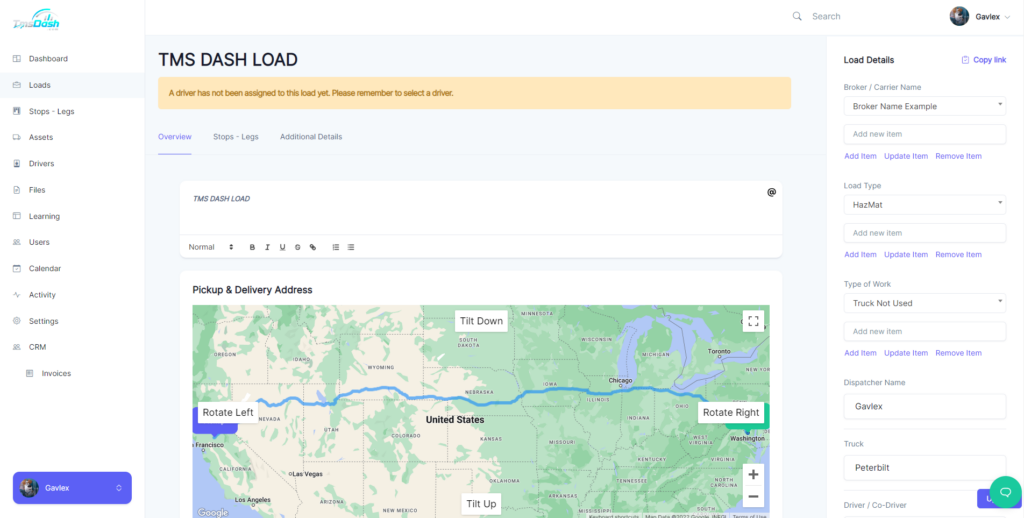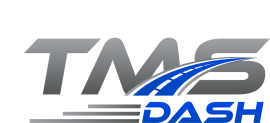TMS+CRM: A perfect combination to benefit the transportation industry!
TMS+CRM:

According to Capgemini Consulting (businesses that successfully switch to digital are 26% more profitable than others), two distinct factors that have already been shown to be effective in the transport and trucks industry are a digital transformation and customer service rules. Innovative digital solutions are growing and collaborating to overcome the challenges you face.
The transportation sector must develop at a higher rate than the rest of the globe to keep up. What, then, do transport companies need? The engineering that will enable this quick evolution. Good news: This technology is available.
Software for managing customer relationships (CRM) provides you with a wealth of knowledge about your clients and potential clients. You can explore your supply-chain management in detail and discover more about your exports and warehouses with the help of a transportation management system (TMS).
For organizing, carrying out, and optimizing the shipment of products, specialist software is known as a transportation management system (TMS). In a TMS, users complete three major tasks: locate and contrast the rates (price ranges) and services of carriers available to send a customer’s order; book the shipment, and finally track the shipment’s progress until delivery.
Improved shipping efficiency, cost savings, real-time supply chain visibility, and customer happiness are the main objectives of adopting a TMS. The main TMS software users are shippers, brokers and carriers. TMS software is also widely used by manufacturers, distributors, e-commerce businesses, wholesalers, retailers, and third-party logistics providers (3PLs).
One of the foundational technologies of supply chain management (SCM), which includes supply chain execution (SCE) and supply chain planning, is a TMS (SCP). TMS can be purchased as independent programs or as modules for enterprise resource planning (ERP) and supply chain management (SCM) suites. Tight margins and rising costs can endanger the viability of your firm, as anyone who owns a small to large trucking company is aware. Costs can be mostly under control when margins change with capacity. Technology always has two sides and offers many advantages. TMS DASH is comparable to magic and can cut operational and labor costs by 40 to 50%.
On the other hand, customer relationship management (CRM) is the collection of procedures, plans, and tools that businesses use to oversee and assess customer interactions and data across the course of the customer lifecycle. The objective is to strengthen interactions with customers to promote client retention and increase sales. CRM systems gather customer information from various contact points between them and the business, such as the company’s website, phone line, live chat, direct mail, marketing materials, and social media. CRM systems can also give staff workers who deal with consumers in-depth knowledge of their data, purchasing history, shopping preferences, and issues.
Transport and logistics companies must cover all aspects of quotes and orders efficiently and accurately, frequently taking into account a wide range of variable costs and different circumstances, in an increasingly competitive market with tight margins where services are being given on time and within budget. Therefore, transportation and logistics companies are modernizing many activities and using technology to gain competitive advantages to satisfy clients and meet their expectations and needs. And the heart of it all is CRM. CRM is a vital piece of equipment for transport and logistics businesses due to its potent combination of task automation, communications, information management, location mapping, and the capacity to streamline the entire order process.
Businesses involved in trucking, shipping, freight forwarding, storage, and other industries are all experiencing disruptions to “business as usual.” How are successful businesses handling their way out and finding new possibilities among all the changes that seem to be rising every day?
With the geopolitical change, staff turnover, interest rate, fuel price increases, shutdowns, and other factors, there doesn’t appear to be enough time in the day to try and establish a strategy and stick to it. Instead, decisions are made quickly.
The best approach is to use tried-and-true procedures for implementing change rapidly without changing what you already do. It would be best if you also took advantage of some incredible technologies that, when integrated, can help you accomplish more with fewer resources and navigate this and future changes.
What happens when two dynamic systems—CRM and TMS—are combined? A 360-degree view of your clients and their cargo will improve your efficiency and give everyone who needs it visibility.

A CRM/TMS combination helps break down barriers because all information is available in one location.
Additionally, this feature enhances your ability to see crucial shipping information. With this information, a business may generate more precise delivery dates, prices, orders, and bids.
CRM integration with TMS for the transportation sector helps improve the administration of operations, vehicles, and infrastructure for the Transportation Service business lines. In terms of the context of policy, regulation, and contract requirements, it includes interaction and activity at all nodes.
For the transportation sector, their combination offers the chance to create intelligent interfaces with all connections across business lines. It covers purchasing and contract management, client and partner management, warehouse management, and sales and marketing management.
BETTER Assumption
A summary of previous orders and shipments for a given time can be seen if you’ve worked with a customer for several years; this is an essential tool for predicting high-priority customer statuses. You can identify where your revenue is originating from with the help of synchronized data. But without this knowledge, the task would be more challenging and perhaps less precise.
ACCESS TO INFORMATION MORE QUICKLY
Faster information access is crucial for sales representatives and technicians who need to assist customers while on the go. What happens if a client queries this expert regarding the procedure for examining a specific tariff schedule or leasing equipment? They would have to go across numerous databases without synced data.
A Deeper Understanding OF THE NEEDS OF YOUR CUSTOMERS
You have a fresh load to convey and a new client. Awesome, right? But the narrative is not over yet. All their other loads still have that new client as a potential customer. The following details about your customer are all available to you once these two systems are synced: shipping statuses, summaries of customer journeys, order histories, payments, warehouse inventories, current rates, and past-due items. To properly understand your clients’ demands, CRM and TMS connectivity is essential.
More Revenue
Thanks to the combination of TMS software and CRM, brokers and other transport companies can plan and optimize with total visibility throughout the shipping process. Thus, this integration aids organizations in boosting their earnings.
Higher Productivity
The productivity of brokers can also be increased with the use of a CRM and TMS. The workflow is managed more effectively with TMS features like scheduling options and load optimization, which increases worker productivity. Through automation and internet access, TMS software will allow businesses to improve their operations while enhancing customer service efficiently.
By helping brokers to interact with consumers more effectively, advanced communication tools increase productivity. Brokers can more effectively track and manage their shipments thanks to TMS software, which unifies all facets of the transportation process into a single system. Additionally, it enables them to always give their clients precise shipping cost estimates in advance.
The systematic approach to monitoring business activities
Understanding when and what needs to be done for which clients are made easier with the help of CRM and TMS connection. You may combine all your business sectors with this IT solution, making it easier to track them all in one location. A transportation company can retain competitive price and delivery options by utilizing this market information.
One place for all the information required
For selection and communication with staff members and departments with various office locations, a CRM+ TMS combination system enables access to continually updated information. It’s a chance to create intelligent, personalized interfaces with all the contacts along business lines that CEOs, CFOs, CIOs, and line managers have at their disposal
.
High EFFICIENCY
Your staff doesn’t have to go back and forth between apps because all your important data is in one location. For instance, if a sales representative is meeting with a customer for a quarterly check-in, the salesperson may need to respond to inquiries regarding previous records and find out the status of a recent shipment or load.
The rep might have to search through two distinct systems if your CRM and TMS systems aren’t integrated. By doing so, you’ll squander their time and risk losing their attention.
Additionally, data entering takes less time for you. The data transfers automatically rather than having to be manually copied from CRM and entered into TMS. Additionally, since there is no need to duplicate data, data entry errors are reduced.
PERFECT USER EXPERIENCE
You may improve the user experience on desktops, laptops, and mobile devices by linking your CRM and TMS. Your UX may suffer if you simultaneously utilize a message system, CRM, TMS, email application, and other apps.
As consumers adopt the upgraded system, merging CRM and TMS enhances the experience. Successful integration can assist in resolving cascading issues, including stale data, user entry issues, and a lack of business insight.
Better Marketing Techniques:
One of the most precious resources a business may have is still customer data. A business can offer more individualized services and execute marketing plans more effectively by better understanding its present and potential clients. But gathering, organizing, and managing all of this data is a difficult effort. Because of this, businesses utilize integrated customer relationship management (CRM) systems in conjunction with Transportation Management Systems so frequently.
Like in all other industries, the client is an important form of capital for the transportation sector. Digital tools are already incorporated at various levels for the daily management of a road transport activity, as was previously mentioned. They are employed far too infrequently for commercial prospecting, monitoring, and customer relationship animation. The acquisition of new consumers through more precise and closely monitored commercial prospecting and loyalty through enhancing the customer experience are now potent axes of growth in a climate where competition is on the rise, such as in transportation. Because of this, using a CRM becomes vital and enhances the TMS by focusing your company on the value of the customer. CRM, often known as customer relationship management software, centralizes your contact information, optimizes client interactions, and improves operations.
Overall, increased productivity and efficiency result from CRM and TMS data. Every business aspires to meet certain benchmarks. You may direct these indicators in the proper direction and assist businesses in achieving their objectives by merging the data from these two platforms.
Reporting by TMS DASH; Writing by Amar; Editing by Gavlex

Responses